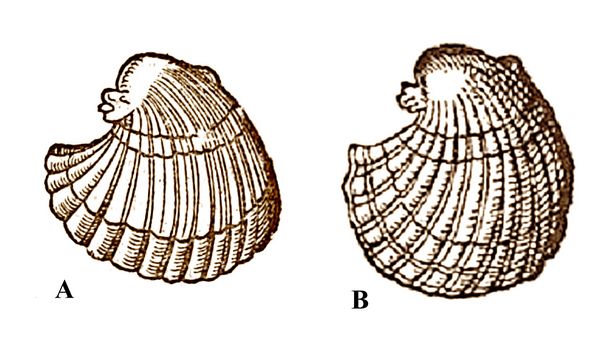Athena Review Image Archive ™
Fossil bivalve drawings by Encellius (1557) and Geissner (1558)

A: Scallop-like bivalve fossil by Encellius (1557); B: by Geissner (1558, Bk.4).
The petrified
mollusk at left (A) was illustrated in the 1557 book De Re Metallaci (On
Metals) by Christoph Encellius (1517-1586), a German priest and highly
regarded geologist. Encellius grouped the fossils with minerals as
natural occurrences which coincidentally resembled the forms of living
creatures.
The next year, however, when the Swiss physician Conrad Geissner (1516-1565), in his Historiae animalium
(1558), compared the drawing by Encellius with an another by Guillame
Rondelet of a living mollusk (B), he realized that Encellius had drawn
a fossilized or petrified shell that was once a living
organism.
Geissner's work represents an important step both towards modern zoology, and the realization that many petrified forms were actually fossils. In his 1565 book “On Fossil Objects”, Geissner compared the closely similar forms of two echinoderms, a modern sea urchin and a lithified heart urchin, and concluded that the latter must have been a living form, and thus was an echinoderm fossil.
References:
Encellius, Christoph 1557 De Re Metallaci (On Metals).
Geissner, Conrad 1552-1558 Historiae animalium (History of Animals) 4 vols.
Geissner, Conrad 1565 On Fossil Objects.
.Copyright © 1996-2020 Rust Family Foundation (All Rights Reserved).